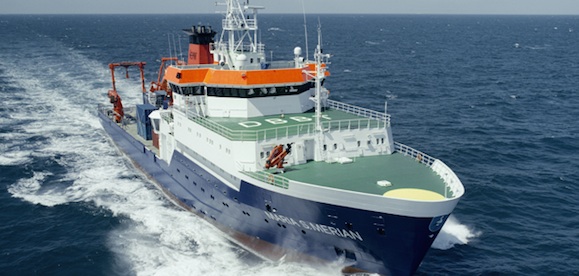The German research Vessel Maria S. Merian arrived this morning and tied up at pier 24. The Ship will be working with Dal Scientists in the Labrador Sea.
On Saturday, August 22 (10-4pm) The ship will be open to the public. Visitors will have a chance to meet the crew and some researchers while touring some of the ship’s laboratories, ocean research technology, inner workings and main deck. More Details about the event can be found at at dal.ca/openship
Visitors of all ages are encouraged and admission is free, but it’s important to note that all those over 18 must show a government issued photo I.D. to enter the Port of Halifax and board the ship.
This will be the ships 46th expedition. (the 45th Concluding in Halifax) The Dal website offers the Following on the Upcoming trip.
The Labrador Sea is an important region to study climate change, as it’s one of only four areas in the world that act as the “lungs” for the deep ocean. In the late winter, very dense surface waters sink into into the abyss, creating “new” deep water that carries oxygen and fossil fuel carbon dioxide into the ocean. In a very real sense, the Labrador Sea “breathes” in oxygen from both the atmosphere and the surface ocean during these events. Deep currents then deliver this oxygen and carbon dioxide to the deepest layers of the ocean all around the world. Observing this region and this “breathing” process can help scientists better predict changes that can impact climate, ocean health and the future potential of the ocean to take up carbon dioxide released from fossil fuels.
When the MSM arrives in Halifax, the crew will begin setting up for its 46th expedition. Dr. Doug Wallace and his team will then load the SeaCycler on board for deployment in the central Labrador Sea. Designed to withstand the challenging ocean conditions in the region, the $1-million SeaCycler will collect detailed simultaneous data for 365 days on oxygen levels, carbon dioxide levels, salinity, temperature, depth, and more—giving scientists a never-before seen understanding of how this important ocean region is changing today and what the implications might be for the future. Read more about the SeaCycler here.
In addition to these hydrographic observations, Dalhousie researcher Dr. Stephanie Kienast will be joining investigators from Germany and other Canadian universities on MSM 46. They’ll be taking water column and sea floor sediment samples to investigate recent changes in ecosystems, the ocean’s biogeochemistry, and the ocean’s pollution levels. The team will then compare recent changes to the natural variations before people had an impact on the Gulf of St. Lawrence and the Labrador Sea.

